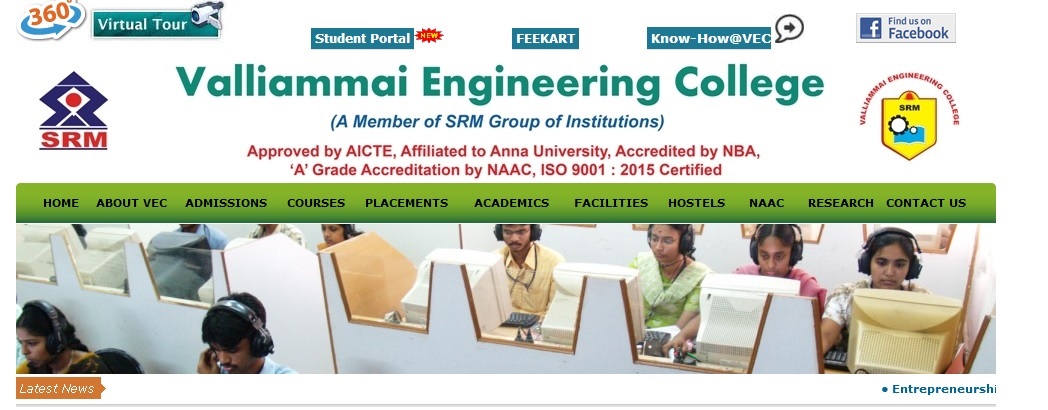CS6301 Programming & Data Structures B.E Question Bank : valliammai.co.in
Name of the College : Valliammai Engineering College
University : Anna University
Department : Information Technology
Subject Code/Name : CS6301 Programming & Datastructures II
Degree : B.Tech – IT
Year : II
Semester : III
Document Type : Question Bank
Website : valliammai.co.in
Download :https://www.pdfquestion.in/uploads/va…uctures-II.pdf
Valliammai Programming & Data structures II Paper
Unit I
Object Oriented Programming Fundamentals :
Part-A (2 Marks) :
1. Define class and object.
2. Define object.
3. When do we declare a member of a class static?
Related : Valliammai Engineering College CS6303 Computer Architecture B.E Question Bank : www.pdfquestion.in/2853.html
4. How is a class declared in C++?
5. What is a scope resolution operator and how can it be used for global variable?
6. What is meant by binding?
7. How the pointer is implemented in C++?
8. What does ‘this’ pointer point to?
9. Define encapsulation.
10. Write the properties of static member function.

11. What is an inline function?
12. State the characteristics of procedure oriented programming.
13. What are the features of Object Oriented Programming?
14. Distinguish between Procedure Oriented Programming and Object Oriented Programming.
15. List out the basic concepts of Object Oriented Programming.
16. State Polymorphism.
17. List and define the two types of Polymorphism.
18. Define Message Passing.
19. List out some of the benefits of OOP.
20. List out the applications of OOP.
21. List out the four basic sections in a typical C++ program.
22. State the use of void in C++.
23. List out the conditions where inline expansion doesn’t work.
24. Why do we use default arguments?
25. State the advantages of default arguments.
26. Define friend function.
Part B (16 Marks) :
1. Write short notes on comparison of conventional programming and OOPS.
2. Explain the control structures of C++ with suitable examples.
3. Write a menu driven program to accept 2 integers and an operator (+,-,*,%,/) and to perform the operation and print the result.
4. Give the syntax and usage of the reserved word inline with two examples.
5. Explain the importance of constructors and destructors with example.
6. Define friend class and specify its importance. Explain with suitable example.
7. Explain the merits and demerits of object oriented paradigm.
8. What are the difference between pointer to constants and constant to pointers?
9. Write a program to get the student details and print the same using pointers to objects and pointers to members of a class. Create a class student. And use appropriate functions and data members.
10. Write a program to demonstrate how a static data is accessed by a static member function.
Unit II
Object Oriented Programming Concepts :
Part-A (2 Marks) :
1. Why is it necessary to overload an operator?
2. What is the need to declare base classes as virtual?
3. What is the use of virtual functions in C++?
4. What is inheritance?
5. What does multiple inheritance mean?
6. List out the operators which cannot be overloaded.
7. What is constructor?
8. Define default constructor.
9. Define parameterized constructor.
10. Define copy constructor.
11. Define dynamic constructor.
12. Define const object.
13. Define destructor.
14. Write some special characteristics of constructor.
15. List some of the rules for operator overloading.
16. What are the types of type conversions?
17. What is an abstract class?
18. What is the ambiguity between default constructor and default argument constructor?
19. What is meant by casting operator and write the general form of overloaded casting operator.
20. Is it possible to overload a constructor? How.
Part B (16 Marks) :
1. Define a class ‘string’. Use overload ‘= =’ operator to compare two strings.
2. What is a parameterized constructor? Explain with example.
3. Describe the syntax of multiple inheritance. When do we use such an inheritance?
4. What is a virtual function? When do we make a virtual function ‘‘pure’’?
5.What is operator overloading? Overload the numerical operators ‘+’ and ‘/’ for complex numbers “addition” and “division” respectively.
6.Define friend class and specify its importance. Explain with suitable example.
7.Explain the concept of inheritance by considering an example of “vehicle”.
8.Explain the operators used for dynamic memory allocation with examples.
9.Write a C++ program to define overloaded constructor and to perform string initialization and string copy.
10.Illustrate the use of copy constructor and function overloading with C++ program.
11.What are the different forms of inheritance supported by C++? Explain with relevant example code.
12.Explain protected data with private and public inheritance.
13.Write a C++ program for to solve eight queens problem with friend functions.
14.Write a C++ program that contains a class String and overloads the following operators on Strings.